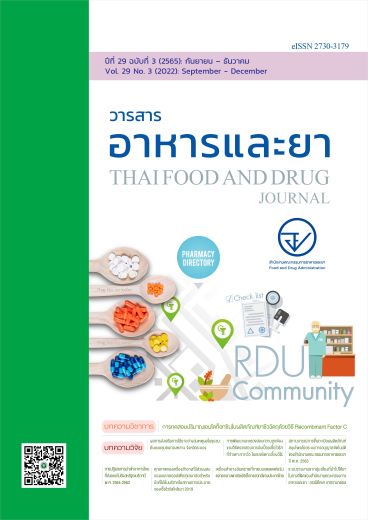คุณภาพของเครื่องสำอางที่มีส่วนผสมของแอลกอฮอล์เพื่อสุขอนามัยสำหรับมือที่ได้รับบริจาคในสถานการณ์ระบาดของเชื้อไวรัสโคโรนา 2019
Main Article Content
บทคัดย่อ
ความสำคัญ: แอลกอฮอล์เพื่อสุขอนามัยสำหรับมือที่มีคุณภาพเป็นสิ่งจำเป็นอย่างยิ่งสำหรับผู้บริโภคในสถานการณ์แพรระบาดของโรคติดเชื้อไวรัสโคโรนา 2019 ซึ่งโรงพยาบาลสนามชัยเขตได้รับบริจาคมาเป็นจำนวนมาก
วัตถุประสงค์: เพื่อศึกษาคุณภาพของเครื่องสำอางที่มีส่วนผสมของแอลกอฮอล์เพื่อสุขอนามัยสำหรับมือที่โรงพยาบาลสนามชัยเขต จังหวัดฉะเชิงเทรา ได้รับบริจาคในช่วงสถานการณ์ระบาดของเชื้อไวรัส โคโรนา 2019
วิธีการวิจัย: การวิจัยนี้เป็นการศึกษาเชิงปริมาณย้อนหลังระหว่างวันที่ 1 มิถุนายน ถึง 30 พฤศจิกายน 2563 เก็บข้อมูลฉลากและผลการทดสอบมาตรฐานแอลกอฮอล์เพื่อสุขอนามัยสำหรับมือที่ได้รับบริจาคด้วยชุดทดสอบ Q-E-S-T 3-in-1 Alcohol Test Kit จำนวน 84 ตัวอย่าง/ยี่ห้อ ที่ขนาดบรรจุ 50 ถึง 1,000 ml ถูกเก็บรักษาในสถานที่ที่เหมาะสม อุณหภูมิไม่เกิน 30 °C ไม่มีแสงแดดส่องถึง และไม่ถูกเปิดใช้งานก่อนการทดสอบ ซึ่งผลิตภัณฑ์ที่มีคุณภาพต้องมีคุณสมบัติครบทั้ง 3 คุณสมบัติ ได้แก่ (1) แสดงฉลากถูกต้องตามประกาศคณะกรรมการเครื่องสำอาง เรื่องฉลากเครื่องสำอาง พ.ศ.2562 และแนวทางปฏิบัติและการแสดงฉลากเครื่องสำอางที่มีส่วนผสมของแอลกอฮอล์เพื่อสุขอนามัยสำหรับมือตั้งแต่ วันที่ 9 มีนาคม 2563 เป็นต้นไป (2) จดแจ้งถูกต้องตามพระราชบัญญัติเครื่องสำอาง พ.ศ.2558 และ (3) ได้มาตรฐาน คือมีความเข้มข้นของเอทิลแอลกอฮอล์มากกว่าหรือเท่ากับร้อยละ 70 โดยปริมาตร และไม่พบเมทิลแอลกอฮอล์เป็นส่วนประกอบ
ผลการวิจัย: พบว่ากลุ่มตัวอย่างมีคุณภาพ ร้อยละ 20.24 ไม่มีคุณภาพ ร้อยละ 73.81 และสรุปผลไม่ได้ ร้อยละ 5.95 เนื่องจากไม่ทราบความเข้มข้นของไอโซโพรพิลแอลกอฮอล์ สำหรับผลิตภัณฑ์ที่พบไม่มีคุณภาพ 54 ตัวอย่าง พบว่ามีการแสดงฉลากไม่ถูกต้อง ร้อยละ 64.29 หัวข้อบนฉลากที่ไม่ถูกต้อง 3 อันดับแรก ได้แก่ ไม่ระบุเลขที่หรืออักษรแสดงครั้งที่ผลิต ร้อยละ 68.52 ระบุเลขที่ใบรับจดไม่ถูกต้อง ร้อยละ 42.59 แสดงชื่อโรคหรือชื่อเชื้อโรคชนิดต่าง ๆ หรือข้อความที่สื่อให้เข้าใจว่าปลอดภัยจากเชื้อโรค ร้อยละ 33.33 นอกจากนั้นเมื่อตรวจสอบข้อมูลการจดแจ้งจากฐานข้อมูล พบว่า กลุ่มตัวอย่างมีสถานะใบจดแจ้งคงอยู่ ร้อยละ 69.05 จดแจ้งไม่ถูกต้องพบไม่ระบุเลขที่ใบรับแจ้ง และสวมเลขทะเบียนของผลิตภัณฑ์อื่น ร้อยละ 16.67 มีสถานะยกเลิกใบจดแจ้ง ร้อยละ 13.95 และไม่พบในฐานข้อมูลสำนักงานคณะกรรมการอาหารและยา ร้อยละ 1.19 ส่วนผลการทดสอบมาตรฐานของกลุ่มตัวอย่างพบว่าผ่านมาตรฐาน ร้อยละ 47.62 ไม่ผ่านมาตรฐาน ร้อยละ 36.90 โดยพบตัวอย่างมีความเข้มข้นของเอทิลแอลกอฮอล์น้อยกว่าร้อยละ 70 โดยปริมาตร ร้อยละ 33.33 พบเมทิลแอลกอฮอล์ซึ่งเป็นสารที่ห้ามใช้ในเครื่องสำอางเป็นส่วนประกอบ ร้อยละ 3.57
สรุป: การศึกษานี้แสดงถึงปัญหาการกระจายของแอลกอฮอล์เพื่อสุขอนามัยสำหรับมือที่ไม่มีคุณภาพ ได้แก่ แสดงฉลากไม่ถูกต้อง จดแจ้งไม่ถูกต้อง ความเข้มข้นและชนิดของแอลกอฮอล์ไม่ได้มาตรฐานตามที่กฎหมายกำหนดไว้ ซึ่งไม่สามารถฆ่าเชื้อได้อย่างมีประสิทธิภาพ เป็นอันตรายต่อผู้บริโภค สะท้อนให้เห็นถึงความจำเป็นอย่างยิ่งที่จะต้องเฝ้าระวัง ตรวจสอบแอลกอฮอล์เพื่อสุขอนามัยสำหรับมือที่ได้รับบริจาคก่อนนำไปใช้
Article Details

อนุญาตภายใต้เงื่อนไข Creative Commons Attribution 4.0 International License.
เอกสารอ้างอิง
World Health Organization. Novel coronavirus (COVID-19) advice for the public [Internet]. WHO Thailand; 2019 [cited 2020 Nov 25]. Available from: https://www.who.int/thailand/emergencies/novel-coronavirus-2019/advice-for-public
กรมควบคุมโรค กระทรวงสาธารณสุข. ข้อมูลสำหรับการป้องกันตนเองจากไวรัสโคโรนาสายพันธุ์ใหม่ 2019 [อินเทอร์เน็ต]. นนทบุรี: กรมควบคุมโรค; 2563 [เข้าถึงเมื่อ 8 ธ.ค. 2563]. เข้าถึงได้จาก:https://ddc.moph.go.th /viralpneumonia/file/introduction/introduction01.pdf
Center of Disease Control (CDC). Coronavirus disease 2019 (COVID-19) [Internet]. 2019 [cited 2020 Nov 25]. Available from: https://www.cdc.gov/coronavirus/2019-ncov
U.S. Food and Drug Administration. Is your hand Sanitizer on FDA’s list of products you should not use? [Internet].2563 [cited 2020 Nov 25]. Available from: https://www.fda.gov/ consumers/consumer-updates/your-hand-Sanitiser-fdas-list-products-you-should-not-use
กระทรวงสาธารณสุข. ประกาศกระทรวงสาธารณสุข เรื่องยกเลิกประกาศกระทรวงสาธารณสุข เรื่อง ผลิตภัณฑ์ที่มีแอลกอฮอล์เป็นส่วนประกอบเพื่อสุขอนามัยสำหรับมือ พ.ศ.2562 .ราชกิจจานุเบกษา เล่มที่ 137, ตอนพิเศษ 54 ง (ลงวันที่ 9 มี.ค. 2563).
กระทรวงสาธารณสุข. ประกาศกระทรวงสาธารณสุข เรื่องกำหนดลักษณะของเครื่องสำอางที่มีส่วนผสมของเเอลกอฮอล์เพื่อสุขอนามัยสำหรับมือที่ห้ามผลิต นำเข้า หรือขาย พ.ศ.2563. ราชกิจจานุเบกษา เล่มที่ 137,ตอนพิเศษ 54 ง (ลงวันที่ 9 มี.ค. 2563).
กระทรวงสาธารณสุข. คำชี้แจงประกาศกระทรวงสาธารณสุข เรื่อง กำหนดลักษณะของเครื่องสำอางที่มีส่วนผสมของเเอลกอฮอล์เพื่อสุขอนามัยสำหรับมือที่ห้ามผลิต นำเข้า หรือขาย พ.ศ. 2563. 2563. [เข้าถึงเมื่อ 8 ธ.ค. 2563]. เข้าถึงได้จาก: https://www.fda.moph.go.th/sites/Cosmetic /Shared %20Documents/Laws/3%20กำหนดลักษณะเครื่องสำอางที่ห้ามผลิต%20นำเข้า%20หรือขาย/คำชี้แจง%20แอลกอฮอล์%20ต่ำกว่า%2070%20ห้ามผลิตนำเข้า.pdf
กระทรวงสาธารณสุข. ประกาศกระทรวงสาธารณสุข เรื่องชื่อวัตถุที่ห้ามใช้เป็นส่วนผสมในการผลิตเครื่องสำอางพ.ศ. 2559. ราชกิจจานุเบกษา เล่มที่ 133, ตอนพิเศษ 114 ง (ลงวันที่ 17 พฤษภาคม 2559).
สถาบันทรัพย์สินทางปัญญาแห่งจุฬาลงกรณ์มหาวิทยาลัย. ชุดทดสอบแอลกอฮอล์แบบทรีอินวัน [อินเทอร์เน็ต]. 2563 [เข้าถึงเมื่อ 8 ธ.ค.2563]. เข้าถึงได้จาก: http://www.cuip.chula.ac.th /?suwp=bddocvw&DOCID=529&fbclid=IwAR1isXnKYvpp2CCChGdvu13C38oqprHcNsEW50aNop1AtS5fKLmyJI3NQos
พระราชบัญญัติเครื่องสำอางพ.ศ. 2558 .ราชกิจจานุเบกษา เล่มที่ 133, ตอน 86ก (ลงวันที่ 8 กันยายน 2558).
กระทรวงสาธารณสุข. ประกาศคณะกรรมการเครื่องสำอางเรื่อง ฉลากของเครื่องสำอางพ.ศ. 2562.ราชกิจจานุเบกษา เล่มที่ 136, ตอนพิเศษ 172ง (ลงวันที่ 8 กรกฎาคม 2562).
กระทรวงสาธารณสุข. แนวทางปฏิบัติและการแสดงฉลากเครื่องสำอางที่มีส่วนผสมของแอลกอฮอล์เพื่อสุขอนามัยสำหรับมือตั้งแต่ วันที่ 9 มีนาคม 2563 เป็นต้นไป (สำหรับผู้ประกอบการ). 2563 [เข้าถึงเมื่อ 8 ธ.ค. 2563]. เข้าถึงได้จาก: https://www.fda.moph.go.th/sites/Cosmetic/Shared%20Documents /alcohol/alcohol.pdf
สำนักควบคุมเครื่องสำอางและวัตถุอันตราย สำนักงานคณะกรรมการอาหารและยา. หลักเกณฑ์การพิจารณาการจดแจ้งเครื่องสำอาง ฉบับปรับปรุง 2562. 2562 [เข้าถึงเมื่อ 11 ธ.ค. 2563]. เข้าถึงได้จาก: https://www.fda.moph.go.th/sites/Cosmetic/PublishingImages/SitePages/Permission/FINAL-หลักเกณฑ์การพิจารณาการจดแจ้งเครื่องสำอาง.pdf
กองบรรณาธิการนิตยสารฉลาดซื้อ. ผลทดสอบเจลแอลกอฮอล์. นิตยสารฉลาดซื้อ [อินเทอร์เน็ต]. 2563 [เข้าถึงเมื่อ 8 ธ.ค. 2563]. 26 (230). เข้าถึงได้จาก: https://www.chaladsue.com/article/3420
กระทรวงสาธารณสุข. ประกาศกระทรวงสาธารณสุขเรื่อง ผลิตภัณฑ์ที่มีแอลกอฮอล์เป็นส่วนประกอบเพื่อสุขอนามัยสำหรับมือ พ.ศ. 2562.ราชกิจจานุเบกษา เล่มที่ 136, ตอนพิเศษ 230 (ลงวันที่ 13 กันยายน 2562).
เกษรา จันทรวงศ์ไพศาล, ชิดชนก เรือนก้อน. สถานการณ์การรับจดแจ้งเครื่องสําอางด้วยระบบ e-Submission และการกํากับดูแลของสํานักงานคณะกรรมการอาหารและยา ปีงบประมาณ พ.ศ. 2559-2562. วารสารอาหารและยา 2564;1(28):60-71.


